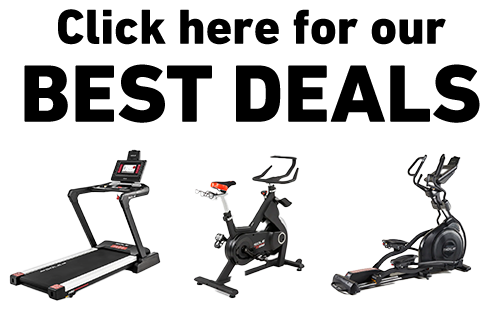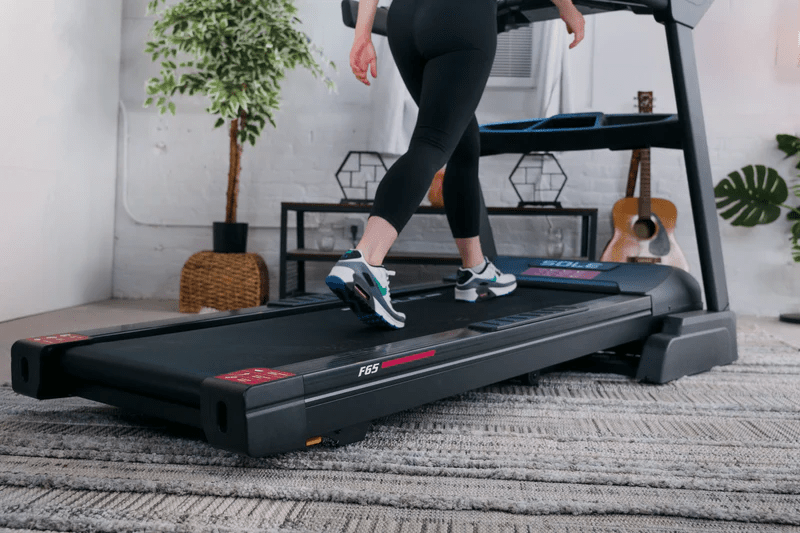Key Takeaways
- A jerking treadmill can disrupt your workout, but regular maintenance can prevent most issues.
- Loose or misaligned belts, lack of lubrication, and motor problems are the most common causes of treadmill jerking.
- Addressing treadmill jerking early ensures smooth operation.
- Regular inspections and maintenance, such as checking belt tension and lubricating the deck, prevent future jerking issues.
- SOLE treadmills are designed with durable components and easy-to-use features to help avoid jerking and provide a seamless workout.
Why Does My Treadmill Jerk & How to Fix It
Experiencing a jerking treadmill can interrupt your workout and lead to frustration. Your treadmill should operate smoothly if you want to avoid issues like an injury. If it doesn’t, there’s likely a mechanical issue at play. But don’t worry—many of these problems are fixable with a little know-how and regular maintenance.
|
At SOLE Fitness, we're proud to offer the best treadmills for your home or gym. These machines are crafted to meet the highest standards of quality and performance, ensuring they are ideal for anyone - from fitness novices to seasoned athletes. Featured Product SOLE Treadmills: Starting at $1,199.99, SOLE treadmills excel in ergonomic design, durability, and value. Equipped with advanced cushioning to minimize joint impact, powerful, quiet motors, and wide running surfaces, they suit any fitness level. |
Common Causes of Treadmill Jerking
- Loose or Misaligned Belt: The belt is often the main culprit when your treadmill jerks. A loose or off-center belt can cause uneven movement as it slips during use.
- Lack of Lubrication: Friction between the belt and deck increases over time if lubrication isn’t applied regularly. This friction can cause the belt to stick or jerk.
- Worn-Out Parts: Parts like the rollers and bearings can wear out, leading to uneven belt movement and jerking.
- Motor Issues: If the motor is struggling, it won’t provide consistent power, leading to jerks in movement.
 Misaligned treadmill belts are a common cause of jerking.
Misaligned treadmill belts are a common cause of jerking.
How to Fix Jerking Issues
Now that you know what can be causing the jerking, here’s how to fix it:
Check Belt Tension: If your belt is loose, it’s likely slipping, which can cause jerking. Most treadmills have rear adjustment bolts you can tighten. Turn them clockwise to increase tension, then test the treadmill at a low speed to see if the jerking has stopped.
Align the Belt: If the belt is off-center, it won’t run smoothly. Start the treadmill at a slow pace and observe its alignment. If it’s veering to one side, adjust the bolts on the back of the machine in small increments using a hex key or an Allen wrench until it runs straight.
Lubricate the Belt: Friction is often the cause of jerking, especially if the treadmill hasn’t been lubricated in a while. Use a silicone-based treadmill lubricant, applying it according to your treadmill’s manual.
Inspect Mechanical Components: Check for any worn-out parts like the rollers or bearings. If these parts are damaged, they might need to be replaced. A squeaking or grinding noise can signal that it’s time to replace these components.
Check the Motor: If the jerking persists, the motor may not be providing enough consistent power. Listen for unusual sounds or check if the motor is overheating. If this is the case, it’s best to call a technician.
 When in doubt, call a technician—persistent jerking may indicate a deeper mechanical or motor issue.
When in doubt, call a technician—persistent jerking may indicate a deeper mechanical or motor issue.
Why Regular Maintenance Prevents Jerking
- Proper Belt Alignment: Monthly belt checks keep it centered, preventing slippage and jerking.
- Reduced Friction: Applying lubricant regularly minimizes wear and tear on the belt and deck.
- Motor Longevity: Clean and inspect your treadmill regularly to ensure the motor stays in good working condition.
At SOLE, we believe regular maintenance is key to keeping your treadmill running smoothly and lasting longer. With our robust design and up to 3 years’ warranty on the deck and parts, we help you reduce the risk of common issues like jerking while providing the security of knowing your investment is protected.
When to Call a Technician
Some issues may be more complicated than just a loose belt or lack of lubrication. If your treadmill jerks even after you’ve tightened the belt and applied lubricant, it can be a more serious mechanical or motor issue. At this point, it’s best to contact a professional. They’ll have the tools and expertise to diagnose and fix complex problems, ensuring your machine doesn’t sustain any further damage.
Keep Your Treadmill Running Smoothly
A jerking treadmill can take the joy out of your workout and cause frustration. However, addressing the problem early keeps your treadmill running smoothly. Preventive care is the key to avoiding these issues altogether and ensuring your treadmill performs at its best.
SOLE: Built for Performance and Reliability
At SOLE, we understand how frustrating a jerking treadmill can be, especially when you’re in the middle of an intense workout. That is why we design our treadmills to ensure a smooth, consistent running experience—built to last and reduce common issues like jerking.
Our treadmills, like the F63 and F65, feature durable construction and tech designed to help you meet your fitness goals. With features such as precision belt alignment and powerful motors, we help prevent the slippage and uneven movement that can disrupt your run. Plus, regular maintenance is made simple with our models—making it easier than ever to keep your equipment in peak condition.
From our F80 to our top-of-the-line F89, SOLE treadmills are equipped with user-friendly consoles and easy-to-use adjustment features, ensuring your workout remains comfortable and jerk-free. You also get access to the SOLE+ App, which features hundreds of free fitness classes to enhance your experience further.
Frequently Asked Questions (FAQ)
Why is my treadmill jerking?
Your treadmill may jerk due to several reasons. Common causes include a loose or misaligned belt, lack of lubrication, worn-out parts like rollers or bearings, or motor issues. A misaligned belt can cause uneven movement, and a lack of lubrication increases friction between the belt and deck, leading to jerking.
How can I fix a loose treadmill belt?
To fix a loose treadmill belt, locate the rear adjustment bolts on your treadmill. Using a hex key or an Allen wrench, tighten these bolts clockwise in small increments. After tightening, test the treadmill at a low speed to see if the jerking has stopped.
How often should I lubricate my treadmill?
Lubrication should be done regularly to reduce friction between the belt and deck. Applying a silicone-based lubricant whenever you notice increased friction or jerking will help ensure smoother movement.
When should I call a technician for treadmill jerking?
You should call a technician if the jerking persists even after you’ve tightened the belt and applied lubricant. More serious mechanical or motor issues may be at play, and a professional can diagnose and fix these problems, ensuring the treadmill doesn’t sustain further damage.






Leave a comment
This site is protected by hCaptcha and the hCaptcha Privacy Policy and Terms of Service apply.